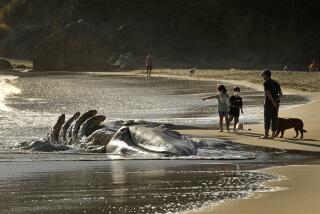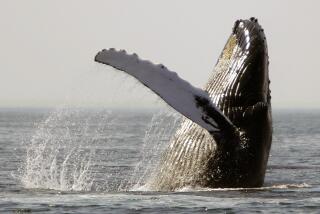In the face of a threat, narwhals respond in just about the worst possible way
- Share via
Narwhals can’t pick whether to freeze or flee after being caught in human hunting nets – and that reaction can put them in grave danger, according to a new study of the marine mammals.
The discovery, described in the journal Science, has implications for the vulnerability of these mammals as they become increasingly exposed to human disturbance.
“They’re pushing their biology as far as they can … and we’re concerned maybe it’s going to push them too far,” said lead author Terrie Williams, an ecophysiologist at UC Santa Cruz.
The narwhal, a beluga-whale relative whose long tusk (on males) has led some to call it the “unicorn of the sea,” spends its life in the Arctic year-round. Because they don’t migrate to warmer climes in the colder months, narwhals have been relatively isolated from human disruption and hunting, compared to other whale species.
But now, as climate change leads to the loss of Arctic sea ice, opening the Arctic up for hunting, shipping and oil exploration, that’s set to change – and some researchers are worried that narwhals will be unprepared to handle the shock.
When animals face a threat, they generally react in one of two ways: They freeze, or they choose to fight or flee. In the freeze scenario, the heartbeat and metabolism slow down significantly; when an animal fights or flees, its heartbeat and metabolism speed up. The two processes are mutually exclusive, pushing the body’s physiology in opposite directions.
Williams had already been using sensors to study the diving physiology of dolphins when study co-author Mads Peter Heide-Jørgensen of the Greenland Institute of Natural Resources asked her to come work with him on narwhals. Heide-Jørgensen had been working with indigenous hunters in Greenland who set out nets to catch fish, seals, narwhals and other animals. They allowed him to tag and release narwhals that were entangled in the nets, so he could track the regional narwhal population’s movements.
For this study, Williams also attached her package of instruments that would allow them to study the narwhals’ diving physiology. This included an electrocardiograph to measure heart rate, an accelerometer to track stroke frequency and a depth monitor to see how far down the narwhals dove. The devices were suction-cupped to five narwhals’ backs and stayed on for one to three days until they fell away and floated to the surface, where they were retrieved.
Truth be told, Williams said, she wasn’t expecting any mind-boggling results from the freed narwhals – just new data on a deep-diving species whose physiology was not well known.
But the data that came back was so jarring that she almost dismissed it.
“I looked at it and the first inclination was to throw away the first five hours or so, because this isn’t normal diving response,” she said. “And then I realized, ‘Oh my gosh, this is a stress response — this is something very different, and very important.’”
When a narwhal dives, its heart rate usually drops, from around 60 beats per minute at the surface to around 10 to 20 beats per minute, which helps it to conserve oxygen until it can come back up to the surface to take its next lungful of air. This is actually typical of all kinds of mammals, including rats and humans: Our heart rates drop when we get a face full of water, Williams said. It’s just more marked in marine mammals, which often need to hold their breath for many minutes at a time as they hunt for food or escape predators.
But in these narwhals, stressed from their encounter with the hunting nets, their heart rates dropped from around 60 beats per minute all the way to just three to four beats per minute. This was not a typical dive response, Williams realized. This was more typical of a “freeze” response in the face of a threat.
And yet, at the same time, the animals were pushing their bodies to the limit, swimming at a rate of 36.6 strokes per minute after escaping the nets – roughly double their usual stroke rate on these dives.
“You had a heart that was only beating three to four beats per minute, and they were swimming in the hardest exercise that we ever see,” Williams said. “That’s why we called it a paradox. I’d never seen anything quite like it.”
Keep in mind, a narwhal’s response to a typical predator – say, a killer whale – is not to speed away, but to slowly sink into the depths beneath cover of ice or move into the shallows where they cannot be reached. These animals are not built for speed, and this extreme flight response was not normal.
Usually, for mammals whose heartbeats slow down as they dive, their pulses will gradually rev up as they keep swimming, just as your heartbeat would rise as you run. But for those narwhals that had been stuck in the nets and handled for an extended period of time, trapped and stressed, their heartbeats stayed at three to four beats per minute long after they escaped, unable to respond to their swimming pace.
“It’s like the heart is frozen,” she said.
This tussle between the dive response, the freeze response and the flight response can put an enormous strain on a mammal’s heart, Williams said, pointing to a 2011 study in the Journal of Cardiovascular Medicine that found that rats that experienced a diving response at the same time as a fear response were at high risk for sudden death.
And Williams, who has competed in Ironman triathlons, noted that the deaths at these competitions often occur during the swimming portion. One possible explanation could be that athletes jumping into the water, amped up at the start of the race, experience the diving response and stress response at the same time – putting a strain on their hearts.
It seems that narwhals are reacting to human threats in a way that puts a tremendous burden on their systems – and while the effects are so far unknown, it could be exposing them to all kinds of long-term damage, including to the brain, the researcher said.
Williams wondered whether whales that strand themselves repeatedly, apparently confused and disoriented, may be suffering from some kind of cognitive damage – the kind that might come from repeated oxygen deprivation. And such strandings of deep-diving whales have been associated with human-produced noise in the oceans, she pointed out.
The findings point to the need for caution as humans make more forays into places like the Arctic and into the Gulf of Mexico, Williams said, where the impacts to vulnerable marine life could be unpredictable and profound.
“My concern is for all of this exploration that we are doing around the world in terms of mineral resources off of coastlines,” she said. “I’m concerned that we just don’t know what the responses of these animals are.”
Follow @aminawrite on Twitter for more science news and “like” Los Angeles Times Science & Health on Facebook.
MORE IN SCIENCE
Add at least 57 to the number of gun-related deaths tied to the Sandy Hook mass shooting
Scientists use CRISPR to turn genes on without editing their DNA
America, it’s time to get ready for the flu







